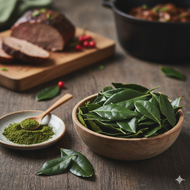A Taste of the Rainforest: Exploring the Complex Heat of Tasmanian Pepper Leaf
Posted by Reese Colbert on 25th Sep 2025
A Taste of the Rainforest: Exploring the Complex Heat of Tasmanian Pepper Leaf
Beyond the familiar aisles of our supermarkets, a vibrant and ancient pantry is waiting to be explored: Australia's native larder. For thousands of years, First Nations peoples have understood the unique flavours of the bush. Today, chefs and home cooks are rediscovering these incredible ingredients, and few are as intriguing or as uniquely Australian as the Tasmanian Pepper.
While the dark, fiery berry often gets the spotlight, its counterpart, the Organic Tasmanian Pepper Berry Leaf, offers a more subtle, aromatic, and complex experience. It's a spice that tells a story of its origins—the cool, damp air of the Tasmanian rainforests—and delivers a heat that is unlike anything else. Let's journey into the world of this remarkable native spice.
The Mountain Pepper: An Ancient Plant
Tasmanian Pepper (Tasmannia lanceolata), also known as Mountain Pepper or Dorrigo Pepper, is a true relic. It's a descendant of ancient flowering plants that grew on the supercontinent of Gondwana, making it one of the oldest spices in the world. This evergreen shrub thrives in the cool, high-altitude rainforests and gullies of Tasmania and the alpine regions of Victoria and New South Wales.
It is dioecious, meaning there are separate male and female plants. The female plants produce the sought-after dark purple-black berries in autumn, while both male and female plants boast the glossy, aromatic leaves that are harvested year-round.
Not Your Average Pepper: Understanding the Unique Heat
The first and most important thing to understand about Tasmanian Pepper Leaf is that it is not related to black pepper (Piper nigrum). The spiciness comes from a completely different natural compound. The heat in black pepper comes from piperine, which provides an instant, sharp sting on the tongue.
The heat in Tasmanian Pepper comes from a compound called polygodial. This compound provides a completely different experience. The heat is not immediate. When you first taste the leaf, you get herbal, woody, and slightly floral notes, almost like a cross between bay leaf and rosemary. Then, after a few seconds, the heat begins to build on the back of the palate—a clean, sharp, and uniquely spicy sensation that lingers pleasantly. This slow-release heat is what makes it such a fascinating and dynamic ingredient to cook with.
Leaf vs. Berry: A Tale of Two Flavours
While they come from the same plant, the leaf and the berry offer different culinary experiences and are used in different ways.
- The Leaf: The Pepper Leaf is the more versatile of the two for everyday cooking. Its flavour is primarily aromatic and herbal, with the spicy heat playing a supporting role. It imparts a beautiful, savoury depth to slow-cooked dishes and is less overpowering than the berry. Think of it as a spicy, native Australian bay leaf.
- The Berry: The Pepper Berry is a fruit, and it has a fruitier, slightly sweet initial taste before its intense, fiery heat kicks in. The berry is significantly hotter than the leaf and is best used when you want a distinct and powerful peppery punch. It's fantastic when cracked over a finished dish like a steak or in short-cooking applications.
How to Cook with Tasmanian Pepper Leaf
Cooking with pepper leaf is an adventure. Its robust flavour holds up well to strong pairings and long cooking times, during which its heat will slowly infuse into the dish. Remember to start with a small amount!
- The "Native Bay Leaf": Add one or two whole dried leaves to your next slow-cooked beef casserole, lamb shank stew, or hearty lentil soup. The leaf will slowly release its aromatic oils and building heat, adding a wonderful, uniquely Australian background note. Just remember to remove the leaf before serving.
- Spice Rubs and Marinades: Crumble or grind the dried leaves into a powder using a mortar and pestle or a spice grinder. This powder is a fantastic addition to rubs for red meats and game. It pairs beautifully with garlic powder, smoked paprika, and other native herbs like lemon myrtle.
- Infused Oils and Vinegars: Gently warm a cup of quality olive oil and add a few whole pepper leaves. Let it infuse off the heat for several hours, or simply place the leaves in the oil and let it sit for a week. The resulting oil will have a spicy kick perfect for salad dressings or for drizzling over roasted vegetables.
- Sauces and Gravies: A single leaf simmered in a red wine jus or a creamy mushroom sauce can elevate the entire dish, adding a subtle warmth and complexity that will have your guests guessing.
Embrace the Flavour of the Australian Bush
Tasmanian Pepper Leaf is more than just a seasoning; it's a taste of the wild, ancient landscape of Australia. It's a chance to step away from the familiar and explore a flavour profile that is both powerful and complex. By learning to wield its unique, building heat, you can add a layer of true Australian character to your cooking, transforming familiar dishes into something new, exciting, and deeply flavourful.

